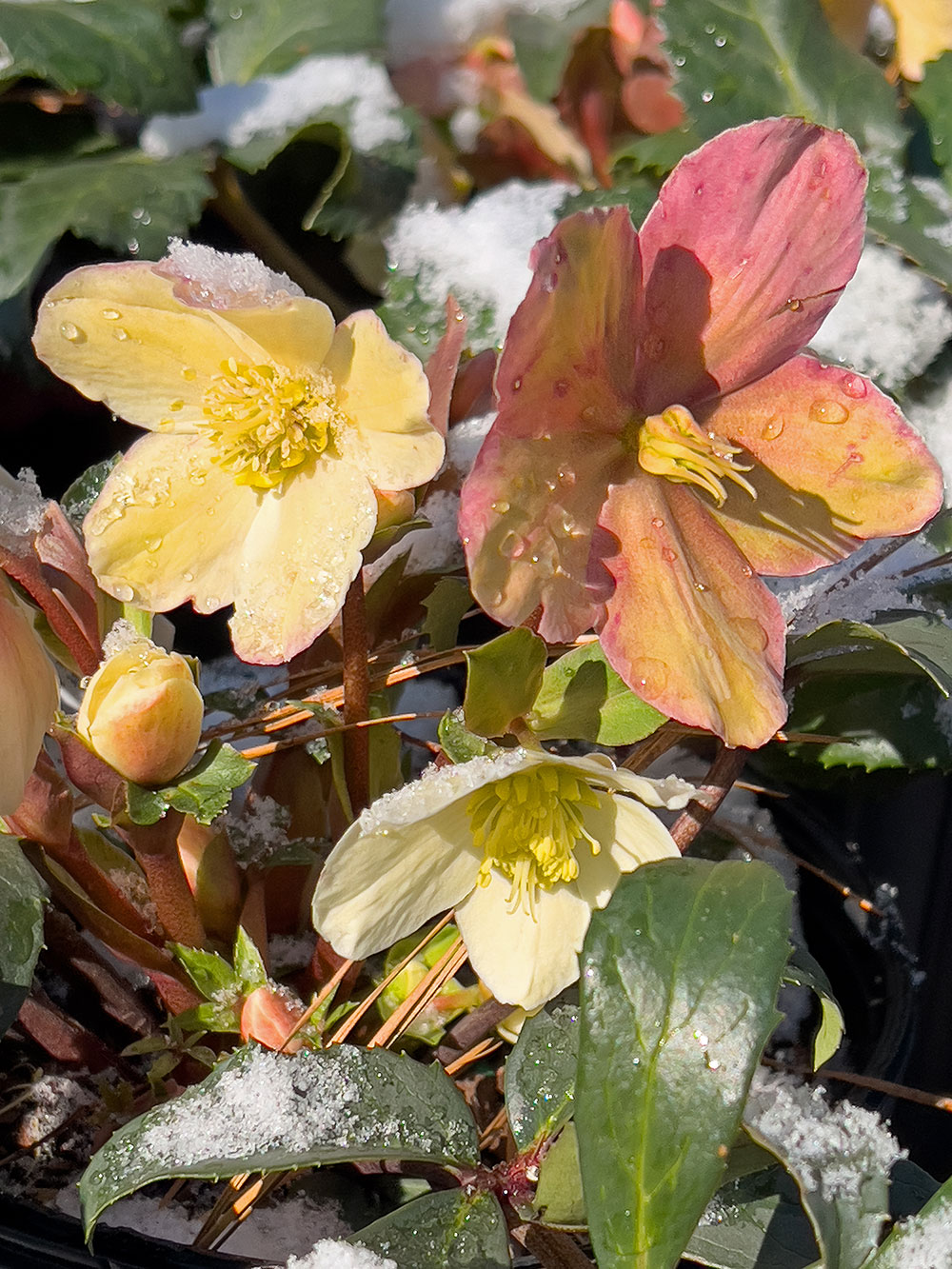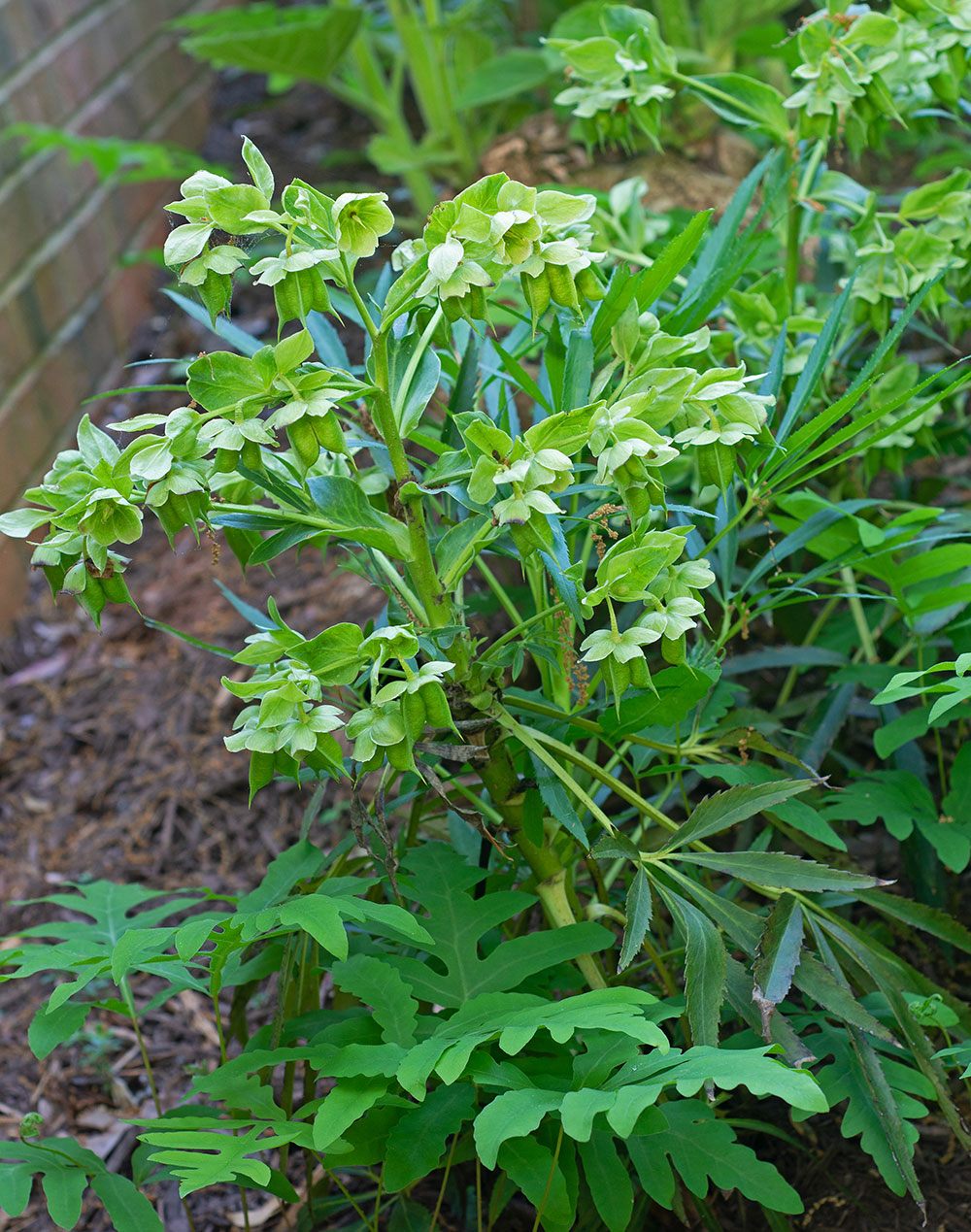Late autumn is a prime time to plant hardy perennials, and many gardeners will be getting downright giddy now over the possibilities. Some backyard growers, however, curb their enthusiasm because, quite frankly, they are impatient, meaning they don’t want to wait until spring to experience full-blooming glory from their planted newbies.
So, why wait? Winter-flowering plants aren’t unusual, and one very pretty example is the hellebore. Often found full of blossoms in local garden centers by the end of the year, these shade-loving perennials shake off the shivers of cold weather by continuing to bloom in January, February, and even into the new spring. Heck, I have even had some with flowers in the early summer!

Lenten rose showing off on a wintry day.
The Christmas rose (H. niger) is another pretty hellebore that’s relatively easy to find and certainly worth the hunt. With white or pink blooms, it flowers slightly earlier than the Lenten rose. Hardy, vigorous ‘Nell Lewis’ was developed in North Carolina and is one of the more popular — and dependable — Christmas rose cultivars.
And there’s the bear claw hellebore (H. foetidus), which flaunts masses of enchanting greenish blooms on plants with deeply cut palmate leaves that resemble, well, bear claws. It will usually begin flowering in January and continue to put on a show deep into the spring.
There are several types of hellebores, but the Lenten rose (Helleborus x hybridus) is an easy-to-find favorite that catches many a gardener’s eye, and for good reason. This Perennial Plant Association’s 2005 Perennial Plant of the Year flaunts masses of bell-shaped blossoms in a wide range of colors such as white, cream, light green, pink, yellow, purple, and salmon, with various variegations merrily mixed in to make buying just a single one of these beauties a problem — but a nice problem to have.
While hellebores will thrive in well-worked soil, once established, these tough plants even show off in dry, shady areas, such as under tall trees. They also do just fine basking in early morning sun. And since hellebores are low-growing plants, potting them up so you can have a better look at their blooms without dropping down on all fours is certainly an option.
My hellebores have readily reseeded and formed ever-expanding clumps of handsome evergreen foliage. ese owing displays occasionally get singed by dry, cold winter winds, but I just prune out the damaged leaves in the early spring, and new ones readily sprout as temperatures start to rise. Speaking of damage, don’t worry about Bambi because hellebores are deer resistant.
Many Lenten roses show up at garden centers simply labeled “Hellebore,” making any attempt at cultivar identify cation ooze with ambiguity. But to me, when it comes to plants, pretty is pretty, and I have lost little sleep enjoying my “mystery” hellebores.
If you are an exacting gardener, however, e-garden shops such as Pine Knot Farms (pineknotfarms.com) and Plant Delights Nursery (plantdelights.com) o er not only a wide range of hellebores in many pretty colors, but ones with proper cultivar names, too.
To Do in the Garden
November
- Hardy herbs such as rosemary, fennel, tarragon, dill, or chives that are persisting in your November garden can be used as fresh flavorings for herb vinegars, which, by the way, make great Christmas presents.
- To keep your African violets looking healthy, wipe the rims around their pots once a month to prevent fertilizer salt buildup, which can chemically burn the undersides of leaves and cause them to curl.
December
- The pleasures of the past summer garden can help brighten up holiday settings naturally with home-grown wreaths weaved from grapevines or evergreen foliage and dolled up with such dried material as hydrangea blooms, onion stalks, corn husks, and chilies.
- Remember your feathered friends this winter by regularly cleaning and refilling the birdbath and feeder. Also, on extremely cold days, be sure to remove any ice from the birdbath and replace with fresh water.
- Out & About in Wake County: November / December 2023
- Iconic Holiday Experiences in The Triangle
- Deck the Porch
- Santa’s Workshop
- Small Business Spotlight: Decree Company
- Erica Chats: Holidays in The Triangle
- On Fire!
- The 2023 Gift Guide
- Pay It Forward: Oak City Cares
- Warm up Wake
- Sleighing the Christmas Spread: Sassool Style
- Celebrated Spirits: Cranberry Cobbler Mocktail
- Celebrated Spirits: Paddle Daze IPA
- Garden Adventurer: Hellebores: Winter Wonders







